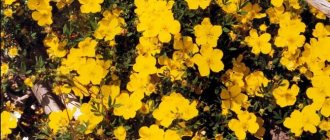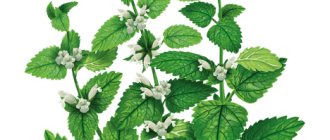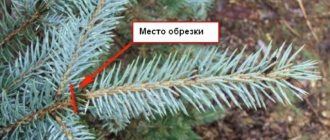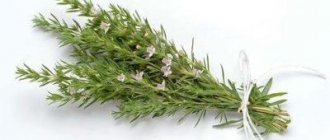Cinquefoil shrub care and cultivation
Among the perennials living in the flowerbed, there are striking specimens that have not only a luxurious appearance, but also useful properties. Compared to its relatives, the cinquefoil shrub stands out favorably and is easy to grow. Its main advantage is good frost resistance, but it also has other secrets, which you will learn about from the article. The article will tell you in detail about the propagation of shrubs, growing conditions, interesting cultivars, beneficial properties, recommendations for combining with other garden inhabitants.
Pruning cinquefoil
When growing shrubby cinquefoil, you must not forget about timely pruning. Otherwise, the plant will quickly turn into a shapeless bush. In early spring and late autumn, all broken, dry branches that thicken the plant are removed from the bush, and the desired shape is created (most often in the form of a ball or pillow).
Potentilla shrub Elizabeth
In addition, in the spring, the growths of the previous year are shortened by 1/3, after the end of flowering the shoots are cut back by a third, and in the fall the overly elongated branches are completely cut out. Every 5 years, anti-aging pruning is carried out “to the stump”.
- Proper pruning of ornamental shrubs - everything you wanted to know
9 techniques for pruning shrubs with a description of the process and diagrams.
Cinquefoil shrub: description, photo
Cinquefoil shrub has long been the subject of controversy among scientists. Botanists could not decide which genus to classify the perennial from the largest family Rosaceae. Previously, it was included in the genus Potentilla of the same name. The name comes from the shape of the leaves, which resemble a small paw.
Later, the genus became known as Kuril tea, because most species grow in Asia and have long been used for brewing a medicinal drink. The Latin name is formed from two words translated as “bearing dense pubescence.” The foliage is densely covered with short hairs. Now the plants belong to a separate genus Pentaphylloides (Pentaphylloides), again due to the shape of the foliage.
This is interesting! Representatives of the genus are so tenacious that they are able to grow in permafrost conditions.
The distribution of cinquefoil is extensive: it covers Asia, Europe, North America, Siberia, Transbaikalia, and the Caucasus. Most representatives prefer to grow in mountainous areas, tundra, forests, meadows, near rivers and streams. They love moderately moist soils with good drainage, but can also grow in dry, depleted soil, where they quickly lose their decorative properties.
Wild varieties of cinquefoil have a shrub habit. The length of their erect shoots varies in the range of 0.1-1.5 m. The graceful branches are highly branched, covered with brown, grayish or red-brown bark, prone to peeling. Young growth is densely covered with thin hairs, adult branches are bare. The shrub is a deciduous species. Carved foliage gives the perennial high decorative qualities. The blade consists of 2-3 pairs of leaves with a trifoliate apex.
The shape of the leaves is oval or oblong-ovate. The length is up to 30 mm, and the width of each leaf does not exceed 10 mm. The surface of the plate is covered on both sides with pressed short hairs.
The bushes are covered with large (up to 35 mm) flowers at the beginning of summer and remain decorative until the end of the season. Numerous flowers appear singly on the shoots or are collected in apical umbellate, corymbose, racemose inflorescences of 2-7 buds. The petals are ovoid, the main color of wild species is yellow. Only the shades of the corollas are variable. Decorative varieties are characterized by an abundance of shades of corollas, growth and shape of the bush. The middle of the flower seems fluffy due to the abundance of stamens.
Each flower lives for 6-48 hours, after which it fades and begins to form a brownish, hairy achene.
Know! The flowering period of Kuril tea with proper care exceeds 2 months. Ungroomed bushes quickly run wild, losing their decorative properties.
Cinquefoil is valued by gardeners not only for its ability to make delicious tea. Long-term abundant flowering, excellent decorative qualities, unpretentiousness, resistance to dust and frost resistance are the undoubted advantages of the perennial.
Types and varieties of cinquefoil bush
The genus Cinquefoil includes only 10 species of shrubs. Based on botanical varieties with yellow corollas, a lot of cultivars with red, pink, cream, orange and white colors have been bred.
The main types of Kuril tea found in culture:
- Daurian;
- shrubby;
- dryadofloral;
- Fridrikhseva;
- small-leaved;
- Manchurian.
Daurian five-leaf plant began to be grown in gardens in 1822. Distributed in the northeast of Korea and China, Siberia, and Primorye. The species received its name due to its large concentration in the territory of Transbaikalia, called Dauria. Prefers to grow on rocky limestone soils, screes, near rivers and in wet meadows. Belongs to calciphiles, i.e. preferring soils rich in limestone.
The shrub reaches 0.5-0.6 m, has bare, dense branched shoots. The leaves are typical for representatives of the genus Pentaphylloides - small, oblong, collected in a “foot” with a pointed middle. The surface of the plate is dense, leathery, glossy.
The upper part of the leaf is green and the lower part is gray. The Daurian variety blooms at the beginning of summer and is pleasing to the eye until the end of the season. At the ends of the shoots, white flowers with a diameter of 20-25 mm are located singly, in pairs or in small umbrellas. In some cultural forms, the petal span reaches 5 cm, but in Russia they prefer to grow the botanical form.
During flowering, complex achenes are formed that ripen by September. If you propagate this species by cuttings, flowering will begin 2 years after rooting.
Know! Botanists assess the winter hardiness of Daurian Kuril tea as complete. Only in the harshest winters do the ends of annual shoots freeze slightly.
Winter hardiness is due to the complete lignification of shoots by the beginning of winter. This means that there is no need to cover the fluffy bushes for the winter. Shrub quinquefoil grows in the same conditions as Daurian, but its range covers more areas - the forests and steppes of Europe, the entire territory of Russia, Central Asia and the Caucasus. Prefers pebbles and rock cracks. Loves moisture and forms extensive thickets. It is cultivated throughout Russia and can grow both in the Arctic Circle and in the southern regions.
The length of the shoots is 1.5 m. The shoots are highly branched, covered with brown, reddish or gray exfoliating bark. The crown has a hemispherical shape, is easy to adjust and retains its compact dimensions for a long time. The foliage is lanceolate-oval, pinnately compound. Each leaf consists of 3-7 lobes up to 30 mm long. The edges of the plates are bluntly pointed, curled, the surface is covered with thick fluff on both sides.
The corolla of the flower consists of 5 oval petals of a golden yellow hue. The diameter of the bud reaches 2 cm. The flowers appear singly in the axils of the leaves along the entire length of the shoot or are collected in small apical scutes. Decorative period from early summer to October. Ripe seed fruits resemble tiny furry buttons. Winter hardiness is high. The perennial is picky about soil composition and prefers soils rich in organic matter.
This is interesting! Depending on the climatic conditions in which the bushes used in hybridization grew, their winter hardiness changes. If the hybrid is of European origin, then its winter hardiness in Russian conditions should be tested.
Americans and Europeans prefer to grow cultivars with different petal colors rather than the wild variety with golden flowers.
Varieties are divided into tall and short, with different colors of leaves and corollas. In the climatic conditions of Russia, not every cultivar will feel great. At the moment, there are over 130 hybrids of the shrub variety. Among them, the following varieties have gained the love of gardeners:
- Abbotswood. Low bushes up to 1 m tall have a dense crown with light green foliage. The diameter of the “cushion” is up to 1.3 m. Snow-white buds with a diameter of up to 25 mm open by the beginning of summer and delight the eye until the end of the season. The best border variety.
- Guildford Cream. A short hybrid 0.4-0.6 m with an extensive crown reaching a diameter of 1.2 m. The bush is densely covered with bright green carved leaves. It blooms from late spring to September with large cream-colored buds.
- Goldfinger. The length of the branches is 1.2-1.5 m. The crown is dense, forming a dense dark green cushion of the same diameter. Bright yellow corollas reach a size of 5 cm. One of the most attractive flowering hybrids.
- Veitchi. Forms spherical bushes with a height and crown girth of about 1.5 m. It stands out with luxurious white petals surrounding a fluffy core with red anthers.
- Golden Star. The growth of the shrub is 0.8–1.0 m, the crown girth is just over a meter. The foliage is grayish-green. The buds are pale yellow, large - up to 5 cm in diameter. The cultivar has a later and shorter flowering from mid-summer to September, which is compensated by abundance.
- Kobold. The shortest variety, reaching a height of 0.5-0.6 m. The crown forms a lush, thick cushion of a light green hue with a diameter of 1-1.2 m. Light yellow corollas open by mid-summer, the decorative effect is 3-4 months. Due to the rapid pace of development, it requires special attention to pruning. Ideal for forming hedges.
- Golden Dwarf. Height 0.6-0.7 m. Graceful branches branch strongly, forming lush light green shoots. Young growths are pinkish-red. The branches are covered with a large number of golden-yellow flowers measuring 20-30 mm.
- Pink Queen. Height 0.8 m, girth up to 1.5 m. The petals are pink, the corolla diameter is up to 4 cm. Decorative during the summer.
- Goldteppich. Hardy hybrid, frost-resistant and resistant to fungi. Valued for its abundant and long-lasting flowering with large golden-yellow buds. The shoots creep and reach a length of just over half a meter. A dense cushion is formed from gray-green foliage.
- Pretty Polly. A bush up to 0.6 m tall forms a very dense, wide (1.2 m) crown of a dark green hue. The petals are slightly lighter at the edges and become dark pink towards the middle. The corolla is 3.5 cm in diameter.
- Jackman. The silvery leaves of the tall hybrid form a spreading crown with a diameter of up to 1.5 m. Light yellow petals open in May, small flowers delight the eye until the end of summer.
- Princess. Dense dark green pads of this hybrid with a girth of up to 1.2 m. Plant growth is 0.7-0.8 m. The shoots are densely covered with pink flowers with a diameter of 30-35 mm. Valued for its early, long-lasting flowering beginning in late spring.
- Klondike. The foliage of this meter-long shrub forms a spreading crown, the color of which gradually darkens by mid-summer. Large corollas open in May and have a light yellow tint. Widely used in ornamental gardening.
- Red ice. The light green pad reaches 0.65 m, with a girth of up to 1.2 m, and consists of delicate creeping branches. By the beginning of June, orange-red petals open, changing their hue to orange-yellow. Decorative all summer long.
- Royal Flush. A short hybrid of American selection. It blooms with red buds that change color to dark pink. In autumn, the dark green foliage turns silver.
- Farreri. The low-growing hybrid changes the shade of the crown from light green to silver. It has medium-sized flowers (3 cm) of dark yellow color.
- Red Robin. It pleases gardeners with bright red petals throughout the summer. The length of the shoots is 0.6 m, the spread is 1.3 m.
- Snowbird. A large number of whitish-cream flowers measuring 4 cm open on a light green cushion 0.7 m long.
- Elizabeth. Among its relatives, the cultivar stands out for its decorative openwork foliage of a bluish-green color. Corollas 40 mm, open by early summer, blooms until October. The petals are painted in light yellow tones.
Know! Despite the abundance of varieties, Russians prefer to cultivate traditional Kuril tea.
Dryad-floral cinquefoil is found in Altai and Central Asia, near the “roof of the world” - the Pamirs. It grows in rocky places, its height does not exceed 12 cm. Creeping shoots are raised, pubescent, and have a reddish tint. Very small leaves are curled at the edges. The flowers are small with a purple calyx and white petals. Not found in ornamental gardening.
Friedrichsev's quinquefoil received its name from the surname of the botanist who described the species. Since the “parents” of this form were the bush and Daurian varieties, in appearance it is practically no different from them. The foliage is bright green, small, pubescent. Flowers over 30 mm in diameter with pale yellow or cream colored petals. A high degree of winter hardiness and the possibility of seed propagation make this species promising for mass landscaping of parks. The height and girth of the bush is 1-1.2 m.
The small-leaved variety is common in Siberia, Mongolia and Central Asia. Due to its short stature (20 cm), it is widely used to decorate alpine slides and rockeries. The leaves are small, the plate is formed from 7-9 pieces. The color of the upper part is gray-green, the bottom of the leaf appears silvery due to the large number of hairs. It has numerous yellow flowers up to 15 mm in diameter.
Important! Of all the species included in the genus Pentaphylloides, only the shrubby one is important for breeders and gardeners. Botanists believe that other forms have been undeservedly ignored.
Manchurian five-leaf plant is common in Primorye and northeastern China. Grows on mountain slopes and screes. Height is about half a meter, girth of silver-white pillows is 0.8 m. Very rare in culture. Young shoots require special attention from gardeners, because the threshold for winter hardiness is very low, adult specimens are frost-resistant. The combination of decorativeness, frost resistance and unpretentiousness makes the Manchurian five-leaf plant promising for gardening and park landscaping.
How to prune shrubby cinquefoil in the fall
Autumn is also a good time for pruning shrubby cinquefoil, since the plants gradually begin to retire, but living and non-living (sick) branches are still clearly visible, which should definitely be gotten rid of as soon as possible.
Why do you need to trim cinquefoil in the fall?
In autumn, cinquefoil shrub can be pruned to rejuvenate the bush or to give it a certain shape. After all, if you complete the pruning before permanent snow falls, then in the spring the cinquefoil shrub will appear in absolutely ideal condition, and you will not need to make time for it during the overly busy spring season filled with other gardening chores.
Deadlines
Autumn pruning is usually carried out after the last flowers have faded or before the threat of frost and permanent snow cover. Calendar dates may vary greatly depending on the specific region. But most often this happens between the end of September and the beginning of November.
Tools and materials
To trim cinquefoil in the fall, you will need the same tools and materials as for the spring procedure.
Rules for pruning Kuril tea in autumn
As a rule, there is no particular need for sanitary pruning in the fall, especially if it was carried out in the spring. But if by this moment broken branches or shoots with signs of disease have appeared on the cinquefoil bushes, they must be cut out.
If in the spring it was not possible to carry out formative pruning for one reason or another, then in the fall they perform all the same operations with Kuril tea as listed above. If in the spring the bushes were already formed, then the essence of autumn pruning comes down to the fact that all branches that by this time protrude beyond the previously defined boundaries are cut off.
Planting cinquefoil
To enjoy the bright flowering of the five-leaf plant, you need to plant it according to all the rules.
Choosing a landing site
Hardy Kuril tea thrives in open spaces. Even the raging cold wind does not frighten this Holarctic perennial. As for lighting, the shrub will be more comfortable in light shade. Direct sunlight does not pose a danger to it, but the petals burn out much faster under the influence of the sun, which shortens the overall decorative period. In full shade, the shoots weaken, lag behind in development and practically do not bloom.
Preparing the soil for planting
Kuril tea is demanding on soil structure. It does not grow well in soil that is too dense or clayey. The close occurrence of groundwater damages the delicate roots, so drainage is required when preparing the planting hole. The optimal composition of the substrate consists of two parts of leaf soil, the same amount of humus and one part of coarse river sand.
Know! Since cinquefoil is a calciphile, it can easily tolerate high levels of carbonates in the soil. Acidity for normal development should be in the range of 5.5-7.5, i.e. from slightly acidic to slightly alkaline.
Characteristics of the planting pit
When preparing a planting hole, it is necessary to take into account a number of requirements. The hole must be dug in advance at least 2 weeks before the planned work. This is done so that the soil has time to compact and air voids do not form during replanting.
The parameters of the hole must be such that the transplanted bush fits completely there. It is necessary to take into account that it is necessary to lay a drainage layer 15-20 cm high. Typically, holes 50-60 cm deep and half a meter in diameter are sufficient, because the root system of Kuril tea is superficial. After the soil is removed from the hole, take the fertile (top) layer and set it aside. When forming a seat, a nutrient substrate is laid in the lower part, and the top layer will consist of the removed fertile layer.
Planting shrubby cinquefoil in spring
Algorithm for carrying out planting work:
- spring planting occurs early, immediately after the snow cover melts and the soil partially melts;
- Place a drainage layer of brick chips or pebbles or crushed stone at the bottom of the prepared pit;
- shorten the central roots of the purchased seedling, forming a branched root lobe with a network of small roots;
- pour a nutrient substrate over the drainage, add 150 g of complete mineral fertilizer to it;
- Place fertile soil on top of the nutrient cushion and compact it thoroughly. The entire mass should occupy approximately half of the hole;
- Place the root system in the hole, distribute the roots and gently sprinkle with fertile soil. If you plant five-leaf clover on uncultivated soil, be sure to fertilize the top layer by mixing it with organic matter (compost, humus);
- make sure that the root collar is at soil level;
- Compact the substrate, water at the rate of 1 bucket for each bush, and mulch with peat chips.
On a note! It is recommended to leave the distance between specimens about 1 m, but it is significantly reduced (up to 40 cm) when forming a hedge.
If you plan to plant the bushes to finish the border, use an alternative planting method. It consists of preparing not individual holes, but long trenches. The requirements for them are the same as for pits. This method is preferable for Kuril tea, because in nature it is used to growing in large thickets.
The nuances of planting cinquefoil in the fall
Autumn planting is carried out similarly to spring, but differs in timing. It is important not to miss the moment and plant the seedlings in a permanent place by mid-September. This is due to the characteristics of the root system. The network of side roots necessary for good rooting develops only in warm weather. If you delay planting, the bush may not have time to take root and will not survive the first winter well.
Aftercare
Kuril tea is a popular shrub. With its help, you can form hedges, create compositions with other ornamental flowering plants, or plant bushes individually. It is easy to care for, but you still have to carry out some procedures.
- Weed the plantings regularly, loosen the soil around the trunk of each plant, and water abundantly during the dry period.
- Spring mulching with peat or wood shavings is recommended - then you will perform all the above-mentioned actions less often.
- If you want Kuril tea to begin to bloom profusely, feed it with a complex mineral mixture intended for flowering plants.
- If it's a hot summer, the cinquefoil may begin to drop flowers. To avoid this, spray it with water from a spray bottle every day in the evening. Then the plant will “breathe” and flowering will continue.
- If you follow all the rules for caring for Kuril tea, it will delight you with good health. However, there are diseases to which this plant is most susceptible: ash fly, rust and spotting. They can be dealt with by treating them with a fungicidal preparation - Bordeaux mixture, Fitosporin.
- Of the harmful insects, the shrubs are most bothered by cutworms. These are nocturnal moths, whose voracious larvae can practically destroy a plant by eating its foliage and damaging the root system. To combat them, purchase an insecticide - “Fitoverm”, “Decis” - and treat the plantings once every 1.5-2 weeks.
- We said earlier that shrubby cinquefoil is a frost-resistant plant that does not require winter shelter. However, this only applies to mature, well-rooted bushes - young trees need to be insulated with fallen leaves.
To learn how to trim cinquefoil, see the following video.
Cinquefoil shrub care
Kuril tea is naturally very hardy, so growing this beautiful and healing plant will not take much effort from the gardener.
Watering
Due to the habitat of natural species in difficult conditions, they have adapted to do without moisture for a long time. When watering, special attention should be paid to young seedlings. For the first 2-3 weeks, irrigate them weekly, and then be sure to loosen the soil to a depth of 5-7 cm and remove weeds.
Important! Mulching will help avoid rapid evaporation of life-giving moisture, so do not neglect this procedure.
If adult bushes are undemanding when it comes to irrigation, then air humidity plays a big role. Water mature specimens only in dry weather, using a bucket of water for each bush. Be sure to spray the green plant in the evenings; this procedure will have a beneficial effect on the condition of the foliage. The absence of sun will prevent damage to the delicate petals and protect the foliage from burns.
Top dressing
If you have added the recommended fertilizer to the planting hole, then the next stage of fertilizing will be in the spring. To ensure long-term decorativeness, the shrub needs a potassium-phosphorus complex. Add mineral salts at the rate of 120-150 g per square meter.
Trimming
The compact dimensions of most cultivars require formative pruning only once every 3-4 years. The crown is formed at the beginning of the growing season, combining it with rehabilitation, or in early autumn. In the first case, remove all dried, damaged and diseased branches, and trim the remaining shoots by 7-10 cm. Autumn shaping is carried out by shortening each branch by a third of the length.
Know! With proper care, green pillows remain compact for 3 years.
Cinquefoil care
Kuril tea is unpretentious and hardy. Caring for it includes watering, fertilizing, cutting, removing faded buds, weeding and loosening the soil. If, after planting, the circle around the trunk is covered with a layer of mulch and updated periodically (3-4 times during the growing season), then you will have to remove grass and weeds and loosen the soil much less often.
Watering
Cinquefoil is drought-resistant, but for rapid growth and mass flowering it requires systematic watering. If the summer is not dry, the bush will have enough rainwater. Young cinquefoil is watered once every ten days, with 3–5 liters of water (not cold) for each bush. In extreme heat, watering is increased up to 2-3 times a week, and the amount of liquid for each five-leaf plant is increased to 10 liters.
Fertilizer application
Cinquefoil bushes are fed in May, July, August or September. The following fertilizers are used:
- During the budding period - mineral complexes for flowering plants or phosphate with potassium sulfate (30 g per bucket of water). The application rate for fertilizing is 10 liters for each bush.
- In the flowering phase - any phosphorus fertilizers. Dilute according to the instructions, add one bucket to each plant.
- At the beginning of spring - phosphorus-potassium fertilizers. The application rate for fertilizing is 10 liters for each bush.
Pruning cinquefoil bush
Trim the bush with sharp pruning shears. The shoots are cut at an angle of 45˚. Cinquefoil trimming is carried out 1-2 times a year:
- in early spring before sap flow - formative, to maintain the decorativeness of the plant and stimulate growth;
- before the onset of frost in the fall - for sanitary purposes.
In the fall, remove old, dry, diseased, weak, broken branches and branches growing inside the bush. When growing Dasyphora in a region with a cold climate, pruning of shrubby cinquefoil is not carried out in the fall. Old branches will retain snow, and under its cover the plant will more easily withstand severe frosts.
In spring, the bush is shaped into a sphere or a pillow. Last year's shoots are cut by 1/3, thickening shoots are cut to the ground. Every five years, cinquefoil needs rejuvenating pruning. It is carried out annually until the bush is completely renewed, removing 1/3 of the old shoots. The bushes are completely rejuvenated in 3-5 years.
Planting shrubby cinquefoil seeds in open ground
You can grow cinquefoil by sowing seeds in open ground. Collecting seed material is not difficult. Collected seeds remain viable for up to 4 years when stored in a cool, dry place.
When to sow seeds
Seeds must be stratified for 3 months before sowing. At the same time, they will germinate faster, but even without stratification, germination is good. In the first case, it is necessary to plant closer to the end of spring, and in the second, in early spring.
Preparatory work in the ground
Typically, sowing work is carried out in heated greenhouses or on a windowsill. Sowing is carried out in seedling boxes. The substrate must be nutritious, loose, and moisture-absorbing. A mixture of leaf soil and sand in a ratio of 2:1 meets these requirements. Be sure to sift the soil mixture.
When sowing directly into open ground, it is better to use stratified material. Prepare a bed in partial shade by replacing the top layer with leafy soil.
Sowing seeds
Seeds are sown in boxes filled with substrate or in a garden bed, in a greenhouse, after watering the soil. Distribute the seed evenly over the surface. There is no need to cover the seeds, just sprinkle them lightly.
Methods for propagating cinquefoil
Kuril tea is propagated both by seed and vegetatively - by cuttings, dividing the bush, and root suckers.
Seeds
We have already figured out how to sow seeds, now let’s talk about caring for the seedlings. It must be said that the seedlings of the five-leaf plant are very small. Therefore, you need to water them carefully, the same applies to fertilizing. It is better to use a sprayer for watering or irrigate using the immersion method. Fertilizers are applied using a syringe.
Attention! During seed propagation, varietal characteristics are not preserved; most often, seedlings return to their original form.
When sowing in early spring, young shoots are planted in separate containers of greater depth. The picking is carried out towards the end of spring, having previously hardened the seedlings. Take the boxes out into the garden, constantly making sure that the seedlings do not get sunburn. When active growth of seedlings begins, apply fertilizing consisting of a complete mineral complex or mullein solution diluted 1:20.
Over the course of a year, the seedlings will grow by 3-5 cm, in the second year of the growing season their growth will be 12-15 cm. Only by 3-4 years will the seedlings become similar to adult specimens and are planted in a permanent place. The seedlings will bloom in 3-4 years.
Since this method does not preserve parental characteristics and takes a long time, it is rarely used at home. Industrial cultivation by seed allows you to get a lot of young individuals at once.
By layering
To obtain layering, the outermost developed shoots are selected. The base is pinched with soft wire and pinned in a shallow groove. Fertile soil is poured on top and cared for in the same way as a queen plant. By the end of the season, a root lobe forms on the branches and they are divided and planted. It is better to leave this event until next spring, then the seedlings are planted in a permanent place.
Advice! A simple proven method will help speed up the formation of roots. Apply shallow wounds to the bark on the underside of the branch and roots will appear in this place.
The basal shoots formed by the bush are separated and planted in a permanent place. Rhizome suckers are produced in small quantities, but can significantly reduce development time. The cuttings will bloom next season.
Dividing the bush
Overgrown bushes 4-6 years old are divided into several parts, obtaining from 2 to 6 new specimens. The procedure is best performed in the spring. Remove the bush and cut the sections with pruning shears. Plant each part in a permanent place. If, when dividing, you left a well-developed root lobe and a number of buds, the young shoots will bloom this year.
Cuttings
Cuttings are an affordable and simple method of perennial propagation.
Main stages:
- When using green cuttings, the material is cut early in the morning or in cloudy weather, when the greatest amount of plant juice is concentrated in it. The length of the cutting is 8-12 cm.
- Remove the lower leaves completely, the upper ones by half, remove the top with flowers so that all the forces of the sprout are devoted to rooting.
- Place the chopped material in a container with heteroauxin for a day, the temperature should not exceed 25⁰C.
- For rooting, use a substrate based on a mixture of peat and sand or perlite. Lay a 10 cm layer of substrate on top of the leaf soil and plant the cuttings to a depth of 3-5 cm in increments of up to 10 cm.
- Rooting is carried out under a transparent cover with frequent spraying (constant humidity) and a temperature of 22-28⁰C. Seedlings are rooted both in greenhouses or nurseries, and on ridges under a film, provided that shading is created.
- After rooting, fertilize with a complete mineral complex. Next year, plant the seedlings in a permanent place.
- In order for the cuttings to successfully overwinter, they must be covered with a 15-20 cm layer of peat mulch.
- Lignified cuttings are cut in early spring, before the buds open. Length 10 cm.
- The rooting conditions are the same, but the cutting is buried so that a 2 cm long tail remains on the surface.
Know! Cuttings allow you to obtain a large number of new individuals, fully preserve the parental characteristics and reduce the growing period to 2 years. Therefore, gardeners often resort to this method of propagation.
Who is herbal medicine indicated for?
Five-fingered herbal medicine is prescribed for heart disease and thyroid dysfunction. For endocrine disorders, the plant is used instead of synthetic substitutes for thyroid hormones - Levothyroxine, Triiodothyronine, Thiamazole, etc. Indications for taking cinquefoil are:
Features of herbal medicine are determined by the form of endocrine disease. The frequency of administration, dosage of herbal remedies and course duration are determined by the attending physician. Irrational use of white cinquefoil is fraught with side effects.
In the absence of hypersensitivity to the components of the drug, it is used to prevent iodine deficiency conditions. The bioactive components contained in the plant restore the functioning of the thyroid gland when it is overactive or has decreased function. Phytoncides and microelements have a beneficial effect on metabolism and normalize the rate of division of thyrocytes. Rapid cell renewal prevents their mutation, the formation of compactions, nodes and cysts.
According to laboratory studies, the maximum amount of bioactive components is contained in the root:
- manganese;
- albinin;
- iodous acid;
- iridoids;
- selenium;
- starch;
- zinc;
- meletin.
Patients with thyroid pathologies are advised to use cinquefoil to prevent iodine deficiency. Dietary supplements and herbal preparations based on the plant restore secretory activity, accelerate the resorption of compactions and prevent diffuse changes in the gland.
If the gland is not functioning sufficiently, patients complain of disturbances in the gastrointestinal tract - intestinal colic, constipation, heartburn, etc. Cinquefoil is a medicinal plant with a wide range of therapeutic properties. It is often used in complex therapy of cardiovascular, gynecological, and gastroenterological diseases. Regular use of pharmaceutical and folk remedies with five-finger prevents atherosclerosis, stool disorders, anemia, hypertension, etc.
Cinquefoil has a pronounced effect, which is due to the presence of elemental iodine in its composition. Therefore, herbal medicine with preparations containing rhizome extract is recommended for all patients with overactive or underactive thyroid gland.
Cinquefoil after flowering: autumn, winter
With the onset of autumn, they stop watering the perennial so that the wood is fully matured. If necessary, prune. Good winter hardiness allows the bushes to overwinter without shelter, but young growth needs it. Clear the root space of fallen leaves and build a fifteen-centimeter layer of peat.
When purchasing a seedling, be sure to take into account zoning, because most hybrids are created on the basis of heat-loving species. Remember a simple rule - good winter hardiness in varieties with white and yellow flowers, lower in red, orange, pink cultivars. They will need shelter for the winter.
Diseases and pests of shrubby cinquefoil, treatment
Cinquefoil has naturally received strong immunity. Pests bypass it, and diseases arise only through the fault of the gardener. Diseases caused by fungi attack foliage when agricultural practices are violated - thickening of plantings, stagnation of moisture in the root zone, excessive moisture, sharp fluctuations in temperature.
Usually spots of various shapes and colors appear on the foliage. With powdery mildew they are whitish, with rust they are brown with a purple coating on the bottom of the leaf, and with spots the color can range from black to yellow. Having noticed traces of fungal activity, you need to remove the heavily affected parts and treat with fungicides - Topaz, Fitoverm, Fitosporin, Fufanon.
Advice! To avoid rust infection, plant the shrub away from the pine tree. The fungus grows on the bark of a tree and, under favorable conditions, disperses spores.
Cinquefoil shrub in landscape design, combination with other plants
Cinquefoil performs well both as a soloist, forming bright cushions, and in group plantings next to taller garden inhabitants. Looks great along borders, as a hedge or as a slope decoration. Low-growing species are appropriate for decorating rock gardens, rocky gardens, and alpine slides.
It exhibits the best decorative qualities in the vicinity of thuja, yew and juniper, hosta, and heuchera. Delphinium, snapdragon, lavender, and hyssop will be excellent neighbors for it.
Beneficial properties of shrubby cinquefoil and contraindications
You will learn from this section of the article how Kuril tea is useful, how to brew it and what contraindications the medicinal drink has.
Shoots, leaves, and flowers are collected from the bush as medicinal raw materials. The herbal drink differs from ordinary tea in aroma and composition; it tastes like black tea. The raw material contains a large amount of ascorbic acid - the concentration of vitamin C is 5 times greater than in lemons!
In addition, the raw materials contain antioxidants, microelements, carotenoids, essential oils, flavonoids, and resins. This composition gives the drink anti-inflammatory, antimicrobial, diuretic, tonic, rejuvenating, anti-cancer, and analgesic properties.
Attention! Allergy sufferers should carefully monitor the body's reaction.
Brew Kuril tea using 2 tablespoons of raw material per 300 ml of hot water. After infusion for 15 minutes, use as tea leaves. Don't drink more than 3-4 glasses a day.
The healing drink will help in maintaining immunity, in the treatment of colds, depression, intoxication, rotovirus, metabolic disorders, enuresis, cystitis, hypertension. Kuril tea has no special contraindications. It is important to monitor your blood pressure levels as they may drop significantly. Therefore, hypotensive patients should use it with caution. If you have allergic reactions to representatives of the Rosaceae family or individual intolerance, it is better to refrain from drinking tea.
Beneficial properties of Kuril tea
The name of the cinquefoil bush comes from the Latin word “potent”, which means “strength, power”. These adjectives fully characterize the medicinal properties of the plant:
- antimicrobial;
- immunomodulatory;
- expectorant;
- bactericidal;
- choleretic;
- antiallergic;
- hemostatic;
- astringent.
Beneficial substances are contained in all parts of Kuril tea. Young shoots and leaves contain a lot of mineral elements (manganese, copper, potassium, magnesium, iron), vitamins C, A, carotene, esters, catechins, phenolcarboxylic acid, tannins. The roots are “rich” in flavonoids, iridoids, and phenolcarboxylic acid. An aqueous infusion of leaves and flowers of Potentilla fruticosa is used for the following conditions:
- neuropsychiatric disorders;
- diseases of the gastrointestinal tract (gastrointestinal tract);
- hepatitis;
- cirrhosis of the liver;
- loss of appetite;
- high blood pressure;
- bleeding from the rectum.
Indications for using alcohol tincture:
- inflammation of the thyroid gland (hypothyroidism and hyperthyroidism);
- heart disease, kidney disease;
- atherosclerosis;
- menstrual irregularities in women;
- anemia;
- severe sweating, shortness of breath;
- heart rhythm disturbance.
Effect of infusion from all parts of Potentilla fruticosa:
- heals burns and wounds;
- treats throat with sore throat, stomatitis;
- helps in the form of douching for leucorrhoea and other gynecological diseases in women;
- treats dysbiosis in children;
- eliminates disturbances in the digestive processes;
- treats urinary incontinence, constipation, cystitis;
- reduces the manifestations of stress.
A decoction from the rhizome of Potentilla fruticosa is used to treat:
- dysentery;
- hepatitis A;
- diarrhea;
- cirrhosis;
- gingivitis;
- tonsillitis;
- ulcers of the stomach and duodenum;
- acute intestinal infections;
- hemorrhoids;
- leg cramps;
- chapped lips, abrasions and wounds on the skin;
- gynecological problems in women.
Forum, reviews
Cinquefoil is loved by gardeners as an ornamental shrub and medicinal plant. Lovers of garden flora speak positively about it, because growing it does not raise any questions even for beginners. Many people prepare raw materials during the summer in order to enjoy aromatic, healthy tea in winter. The only point in cultivation that can confuse a beginner is reproduction. Experienced gardeners recommend using woody cuttings.
Conclusion
Cinquefoil shrub is a very unpretentious inhabitant of the garden plot; caring for and growing the perennial will bring gardeners a lot of pleasure. And the ability to strengthen the immune system with a healing drink sets Kuril tea apart from other shrubs.
Pruning cinquefoil: timing and methods, useful recommendations
Decorative flowering plants are undoubtedly a decoration for any garden plot. Some of them are quite capricious and difficult to cultivate, while others, on the contrary, do not require special care and are able to please their owner for many years. The latter includes shrubby cinquefoil, or Kuril tea. It is a perennial (its lifespan can exceed 20 years), different varieties have different parameters (50-100 cm in width and height).
However, any of the varieties needs timely pruning in order to maintain an attractive appearance. Read about how to produce it correctly in our material.










